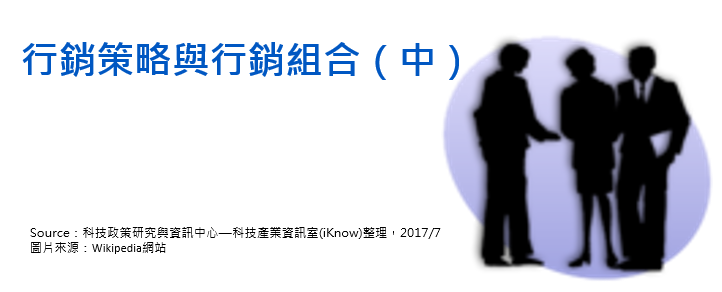
圖、行銷策略與行銷組合(中)
基於上文說明,行銷( marketing )就是找到市場(若沒有市場就要想辦法創造一市場),並且擬定產品與服務賣給市場上客戶以換取金錢($)之策略規劃過程。此外,行銷屬於規劃力一環,因此常牽涉到一系列之邏輯分析,換言之,理性思考與分析乃是行銷規劃不可或缺要素。
一般而言,行銷包括三階段,首先為環境分析階段( environmental scanning ),其次為行銷策略規劃階段( marketing strategy ),最後為行銷組合階段( marketing mix )。
環境分析階段
環境分析與【 SWOT 、 PEST 與五力分析】和【價值鏈、價值系統、產業鏈與微笑曲線】討論內容接近,包括總體環境分析(即是 STEEPLE )、產業環境分析(即產業鏈分析與價值鏈分析)與企業層級環境分析(即五力分析與 SWOT 分析等)。環境分析即是要瞭解行銷產品與服務所處的整體環境,由大到小,由全球到企業等。
環境分析階段的完成(查核點)是以有沒有畫出 SWOT 矩陣論,當 SWOT 完成,初步環境監控的階段即算是成功。
行銷策略規劃階段
行銷策略分析( marketing strategy )即是行銷學上常稱 STP 流程( STP Process ),其中 S 為 ” 市場區隔化 ” ( Segmentation )、 T 為 ” 選擇目標市場 ” ( Market Targeting )而 P 為 ” 市場定位 ” ( Positioning )等。根據楊東震教授之行銷學講義,相關步驟可表示為 [4] :
• 市場區隔化( S ):確認區隔化變數、區隔市場並描述各場區隔的輪廓
• Step1 調查階段:蒐集並挖掘消費者有關動機、態度、行為。
• Step2 分析階段:將所蒐集的資料利用統計方法集群不同區隔之群體。
• Step3 剖化階段:將每一集群依其特有之態度、行為、人口統計、心理統計、消費習慣等,一一加以描述,以各集群 ( 區隔 ) 之特徵來命名。
• 選擇目標市場( T ):評估每一區隔的吸引力並選擇目標市場
• Step1 :首先行銷者必須對這些區隔,就其規模大小、成長、獲利、未來發展性等構面加以評估;
• Step2 :其次考量公司本身的資源條件與既定目標,從中選擇適切的區隔做為目標市場。
• 市場定位( P ):為每一目標區隔發展定位觀念
• Step1 : 找出可能的潛在競爭優勢來源
• Step2 : 選擇競爭優勢
• Step3 : 發出競爭優勢的訊息
詳細資料可詳見參考資料 [4] 或是黃俊英教授之《行銷學的世界》第七章「目標市場與定位」。
行銷策略規劃階段的完成是以有沒有找到企業本身的產品與服務定位論,因此最終市場定位的釐清與擬定為本階段重要查核工作。
行銷組合階段
產品行銷組合( marketing mix )即是進一步(細部)的行銷策略規劃,有點像策略規劃過程中的執行方針( Action plan )擬定,傳統上常聽到的行銷 4P 、行銷 7P 或是行銷 4C 即是對應行銷組合分析的相關專有名詞。
行銷 4P 即是 Product (產品)、 Pricing (價格)、 Promotion (促銷)與 Placement (通路), 分別說明如下 [1] :
• Product (產品) : The Product management and Product marketing aspects of marketing deal with the specifications of the actual good or service , and how it relates to the end-user's needs and wants.
• Pricing (價格) : This refers to the process of setting a price for a product, including discounts .
• Promotion (促銷) : This includes advertising, sales promotion, publicity, and personal selling , and refers to the various methods of promoting the product, brand, or company.
• Placement (通路) or distribution refers to how the product gets to the customer; for example, point of sale placement or retailin g. This fourth P has also sometimes been called Place, referring to “where” a product or service is sold, e.g. in which geographic region or industry, to which segment (young adults, families, business people, women, men, etc.).
除了上述 4P 外,另外常見的行銷 7P 即是在上述四項因素下增加另外三項,包括 [1] :
• People (人員) : Any person coming into contact with customers can have an impact on overall satisfaction . Whether as part of a supporting service to a product or involved in a total service, people are particularly important because, in the customers' eyes, they are generally inseparable from the total service. As a result of this, they must be appropriately trained, well motivated and the right type of person. Fellow customers are also sometime refereed to under 'people', as they too can affect the customers service experience (e.g. at a sporting event).
• Process (流程) : This is the processes involved in providing a service and the behaviour of people , which can be crucial to customer satisfaction.
• Physical evidence (具體感受) : Unlike a product, a service cannot be experienced before it is delivered, which makes it intangible. This therefore means that potential customers perceive greater risk when deciding whether or not to use a service. To reduce the feeling of risk, thus improving success, it is often vital to offer potential customers the chance to see what a service would be like. This is done by providing physical evidence, such as case studies, or testimonials.
需要說明,上述不論行銷 4P 或 7P ,多屬於站在產品供應端( supply side )的思考架構論,若以需求端( demand side )論,即有行銷 4C 概念提出,文獻上包括傳統行銷 4C 與新興電子商務行銷 4C 等 [5] :
• 傳統行銷 4C :顧客需求( Customer )、顧客成本( Cost to the customer )、便利( Convenience )、溝通( Communication )
• 網路行銷 4C :顧客經驗( Customer Experience )、顧客關係( Customer Relationship )、溝通( Communication )、社群( Community )
如果將供給端 4P 與需求端 4C 建立對應關係,則可得如表一之對照表,其中買賣雙方的對象均為產品與服務( product ),因此獨立出來,其餘 4P 與 4C 可清楚由供給端與需求端角度釐清,例如 people 即是供給端的客服人員,而 customer 即是需求端的消費者等。
行銷組合階段的最終查核工作即是每一產品或是每一產品線的 4P 與 4C 策略。
最後,上述所論行銷三階段,包括環境分析階段、行銷策略規劃階段與行銷組合階段等,初步看起來是一線性思考關係,但是實際執行上,應該在每一階段完成後,回饋( feedback )到前一階段進行修正( iteration )與思考方向調整,亦即工業管理中 PDCA 環之流程管控也需要進一步引入到相關行銷策略規劃流程中。 (1904字)
表一 4P 與 4C 對應關係
|
Product
|
|
Supply side
|
Demand side
|
|
People
|
Customer
|
|
Price
|
Cost to the customer
|
|
Place
|
Convenience
|
|
Promotion
|
Communication
|
參考資料: